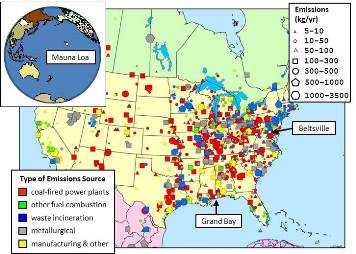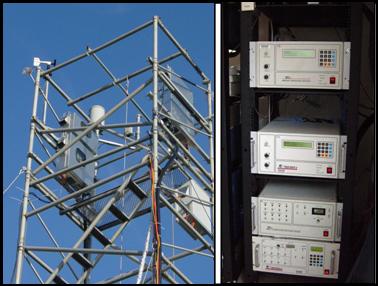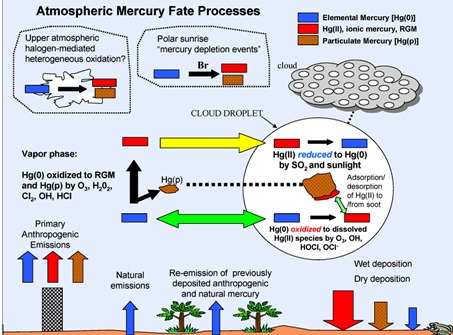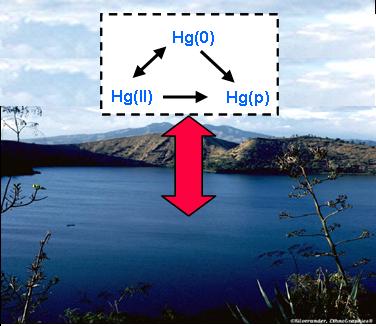Atmospheric Mercury Measurements

Location of ARL’s three long-term speciated atmospheric mercury measurement sites (Mauna Loa, Beltsville, Grand Bay), overlain on a map of large mercury point sources (for 2002) based on data from the U.S. EPA and Environment Canada.
Overview:
In conjunction with the National Atmospheric Deposition Program’s (NADP) Atmospheric Mercury Initiative, ARL operates three stations for the long-term, research-grade monitoring of concentrations of mercury species and other trace pollutants in the atmosphere:
- Grand Bay, MS, in collaboration with the NOAA Grand Bay National Estuarine Research Reserve (NERR) and the U.S. Fish and Wildlife Service’s Grand Bay National Wildlife Refuge
- Beltsville, MD, in collaboration with the U.S. EPA
- Mauna Loa Observatory, Mauna Loa, HI, in collaboration with NOAA’s Earth System Research Laboratory and the U.S. EPA
Goals and Objectives:
- Assemble a long-term, publicly available data record
- Establish correlations with meteorology and ancillary trace species to better understand the emission, transport, transformations, and fate of mercury in the atmosphere
- Discern trends in atmospheric mercury concentrations
- Derive dry deposition estimates
- Elucidate mercury source-receptor relationships
- Provide a data set for model evaluation
At each site, ambient air concentrations of gaseous elemental mercury, reactive gaseous mercury, and fine particulate mercury are measured. In addition, ambient air concentrations of trace gases (e.g., sulfur dioxide, nitrogen oxides, carbon monoxide, ozone) are measured. Meteorological parameters such as temperature, humidity, precipitation, wind speed and direction are also measured. Wet deposition measurements are being made following Mercury Deposition Network (MDN) protocols at the Beltsville site by collaborators (Univ. of MD, State of MD) and MDN sites are planned to be implemented at the Grand Bay and CVI sites as resources permit. Deposition in precipitation is quantified through chemical analysis of collected rain and snow samples.
In addition to the three long-term sites noted above, a number of short-term mercury measurement campaigns have been carried out, including the following: Cove Mtn, TN (Summer 2002); Gulf of Mexico (Ship) (Summer 2003); Oxford and Wye, MD (Summer 2004); Harcum, VA (Summer 2005); Houston, TX (Summer 2006).
Grand Bay NERR, MS:

(a) Measurement tower at Grand Bay NERR, showing two sets of Tekran reactive gaseous mercury and fine particulate mercury collection units; (b) Mercury measurement equipment in climate-controlled trailer adjacent to tower.
Speciated ambient mercury measurements began at the Grand Bay NERR in September 2006. Mercury measurements at this time were made with a single Tekran instrument suite at a temporary location (30.4294o N, -88.4277o W). In 2007, a second Tekran instrument suite was added and the site location was moved to its permanent location on FWS Grand Bay National Wildlife Refuge property adjacent to the Grand Bay NERR (30.412o N, – 88.404o W). In January 2010, an aerosol soot carbon monitor was added as a tracer for combustion processes. In March 2010, a National Atmospheric Deposition Program (NADP) Mercury Deposition Monitoring site was established and includes measurements for total mercury, trace metals, and monthly composite for methyl mercury in precipitation. An NADP National Trend Network site was also established at that time to measure major ions in precipitation.
NOAA’s National Ocean Service’s National Centers for Coastal Ocean Science provided assistance in purchasing measurement equipment for the site. Summaries of activities and measurements at the Grand Bay NERR site are available [1], [2], [3], [4], [5].
The two co-located mercury measurement systems at the site are particularly useful in that they:
- provide quality control and quality assurance information (by comparing the concentrations measured by the two instruments)
- allow methodological refinements to be tested
- allows continuity of measurements in the event of instrument failure
- allows for truly continuous measurements to be made if the instruments are operated asynchronously (note: due to inherent instrument operating conditions, the Tekran speciated mercury measurement suite provides concentration data in a periodic fashion, e.g., measurements for one hour and then no measurements for the next hour, etc. With two instruments operating asynchronously, it is possible to collect truly continuous measurements.)
Beltsville, MD:
In November 2006, the U.S. EPA Clean Air Markets Division (CAMD) and ARL established a comprehensive atmospheric mercury monitoring site (39.0284o N, -76.8172o W) near Beltsville, Maryland, on the campus of the USDA Beltsville Agricultural Research Center, and bordering the U.S Fish and Wildlife Service’s Patuxent National Wildlife Refuge (NWR). The site is located on parkland embedded within a suburban portion of the Washington, DC metropolitan area, and is representative of much of the semi-urban nature of the Chesapeake Bay watershed. Other collaborating organizations at the site include the State of Maryland Department of Natural Resources and the University of Maryland. The Howard University Atmospheric Observatory, a multi-agency research facility for the study of atmospheric physics and chemistry, lies approximately 5 km to the northwest.
The Beltsville site includes two Tekran speciation systems measuring Hg0, RGM, and Hg(p), like the Grand Bay NERR site, providing comparable quality assurance, continuity and other benefits. Mercury compounds, ancillary trace gases (SO2, O3, CO, NO, NOy), and meteorological parameters are measured at a height of 10 meters to minimize local surface effects. The site also hosts measurements under the EPA CASTNet, NADP/NTN (major ions in precipitation) and MDN (mercury wet deposition) programs. These existing co-located measurements were an important factor in choosing the Beltsville location for enhanced mercury monitoring. Summaries of activities and measurements at the Beltsville site are available [3], [5], [6].
Mauna Loa Observatory:
-

Dr. Winston Luke and Dr. Akane Yamakawa installing sampling equipment on the mercury platform at NOAA’s Mauna Loa Observatory. Credit: NOAA
In January 2011, ARL partnered with NOAA’s Earth System Research Laboratory and EPA’s Clean Air Markets Division (CAMD) to continue speciated mercury measurements at the Mauna Loa Observatory (MLO) near Hilo, Hawaii. EPA’s Office of Research and Development established mercury measurements at MLO in 2001 (date approximate), but in 2011 funding for the site was transferred to CAMD.
MLO is located on the Island of Hawaii at an elevation of 3397 m on the northern flank of Mauna Loa volcano. The observatory was established in 1957, and is one of six global baseline monitoring stations for the study of the background global atmosphere. The first long-term carbon dioxide (CO2) measurements illustrating the seasonal and inter-annual variations in carbon dioxide (the “Keeling curve”) were made at MLO. Now, up to 250 different atmospheric parameters are measured there by a complement of 12 NOAA/ESRL and other agency scientists and engineers.
Species and parameters measured include carbon cycle flask sampling (for greenhouse gases, hydrocarbons, and measurements of carbon and oxygen isotopes); in situ carbon cycle and halocarbon measurements; aerosol measurements; continuous radiation measurements; surface and column ozone; lidar observations; and meteorological parameters. See the MLO web site for more information.
A single Tekran speciation system measures elemental mercury (Hg0. 5-minute measurements), reactive gaseous mercury (RGM, 1-hr measurements) and fine-particulate bound mercury (FPM. 1-hr measurements).
Winds are typically from the east and northeast (trade wind circulation), with local upslope (daytime) and downslope (nighttime) circulations superimposed on the mesoscale and synoptic flows.
Documents available for viewing or download
- Grand Bay Measurement Summary (also available as a PowerPoint presentation [15 MB]). Authors: Winston Luke and Mark Cohen. A set of slides summarizing mercury activities and measurements at the Grand Bay NERR, prepared in January 2008.
- Atmospheric mercury measurements in the Gulf of Mexico region: Early results from an emerging monitoring network(also available as a PowerPoint presentation [4 MB]). Authors: Winston Luke, Mark Cohen, Paul Kelley, Steve Brooks (NOAA/Air Resources Laboratory) and Jake Walker (Grand Bay NERR). Prepared for NADP 2007 Technical Committee Meeting, Boulder, CO, Sept. 10-13, 2007.
- Briefing for the USEPA Clean Air Markets Division regarding collaborative mercury measurements(also available as a PowerPoint presentation [15 MB]). Authors: Winston Luke and Mark Cohen. Prepared for a meeting between NOAA ARL and the U.S. EPA Clean Air Markets Division, Oct 1, 2007, in Washington D.C.
- Mercury-Related Research/Monitoring Activities – Grand Bay National Estuarine Research Reserve, Mississippi. A two-page handout summarizing mercury measurement activities at the Grand Bay NERR, prepared for the National Mercury Monitoring Workshop, May 2008, in Annapolis, MD.
- Mercury Measurement Programs within NOAA/ARL (also available as a PowerPoint presentation [10 MB]). Authors: Steve Brooks, Mark Cohen, Tilden Meyers, Paul Kelley, Winston Luke. Prepared for the NOAA Atmospheric Mercury Meeting, November 14-15, 2006, Silver Spring, MD.
- Mercury Monitoring at the Beltsville Agricultural Research Center/Patuxent NWR . A two-page handout prepared for the National Mercury Monitoring Workshop, May 2008, in Annapolis, MD.
- Mercury Monitoring in the Mid-Atlantic Highlands . A two-page handout summarizing mercury measurement activities at the Canaan Valley Institute, prepared for the National Mercury Monitoring Workshop, May 2008, in Annapolis, MD.






